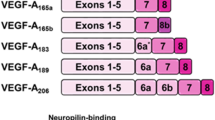Abstract
Vascular endothelial growth factor (VEGF) was discovered 10 years ago as a growth factor that can regulate angiogenesis and in addition the permeability of blood vessels. Numerous studies have revealed that it is essential for normal embryonic development and that it plays a major role in physiological and pathological events of angiogenesis in adults. It is unique in that its expression is regulated directly by hypoxia. These properties are now being exploited in attempts aimed at the induction of new blood vessels in pathological situations such as ischemic heart disease. Five VEGF forms of 121 to 206 amino-acids are produced from a single gene by alternative splicing. Cells expressing VEGF usually express several forms simultaneously. VEGF121 does not contain exons 6 and 7 of the gene and consequently lacks a heparin binding ability. However, this form is fully active as an inducer of angiogenesis, and as a blood vessel permeabilizing agent. Exon 6 and 7 contain 2 independent heparin binding domains. The VEGF form containing exon 7 (VEGF165) and the vascular endothelial growth factor form containing exon 6 (VEGF145) display similar biological potencies raising the question of why so many VEGF forms are required. It was found that VEGF121 diffuses better because it does not bind to heparan-sulfate proteoglycans. In contrast, VEGF145 binds to extracellular matrix ad is released from it slowly. When the receptor binding properties of VEGF121 and VEGF165 were compared it was found that VEGF165 binds to a class of VEGF receptors that is not recognized by VEGF121. These receptors are encoded by the neuropilin-1 gene, and we have recently found that the related neuropilin-2 gene also encodes a VEGF165 receptor. We have recently found evidence indicating the neuropilins form complexes with another VEGF receptor, VEGFR-1. However, the biological function of this complex remains to be elucidated.
Zusammenfassung
Der “Vascular Endothelian Growth Vactor” (VEGF) wurde vor zehn Jahren als Wachstumsfaktor entdeckt, der an der Regulation der Angiogenese und Permeabilität der Blutgefäße beteiligt ist. Zahlreiche Untersuchungen haben gezeigt, daß er essentiell für die normale embryonale Entwicklung ist und daß er eine entscheidende Rolle bei physiologischen und pathophysiologischen Vorgängen der Angiogenese spielt. Einzigartig ist, daß seine Expression direkt durch Hypoxie reguliert wird. Diese Eigenschaften werden genutzt, um neue Blutgefäße, zum Beispiel bei ischämischer Herzkrankheit, zu induzieren. Ausgehend von einem Gen, werden fünf verschiedene VEGF-Isoformen von 121 bis 206 Aminosäuren durch alternatives “Splicing” gebildet. Zellen, die VEGF exprimieren, produzieren meistens mehrere Isoformen gleichzeitig. VEGF121 enthält nicht die Exons 6 und 7, und daher fehlt eine Heparinbindungsstelle. Diese Form wirkt trotzdem als Angiogenesefaktor und steigert die Blutgefäßpermeabilität. Exon 6 und 7 enthalten zwei unabhängige Heparinbindungsstellen. Die VEGF121-Isoform, die Exon 7 enthält (VEGF165), und die VEGF-Isoform mit dem Exon 6 (VEGF145) haben eine ähnliche biologische Wirkung, und es stellt sich die Frage, warum mehrere VEGF-Isoformen benötigt, werden. Es wurde gefunden, daß die VEGF121-Isoform besser diffundiert, da sie nicht an Heparansulfat-Proteoglykane bindet. VEGF145 bindet dagegen an die Extrazellulärmatrix und wird von ihr nur langsam wieder freigesetzt. Ein Vergleich der Rezeptorbindungseigenschaften von VEGF121 und VEGF165 zeigte, daß VEGF165 an eine Gruppe von vaskulären endothelialen Wachstumsfaktorrezeptoren bindet, die von VEGF121 nicht erkannt werden. Diese Rezeptoren werden vom Neutropilin-1-Gen kodiert, und wir konnten vor kurzem zeigen, daß das verwandte Neutropilin-2-Gen auch einen VEGF165-Rezeptor kodiert. Auch konnten wir nachweisen, daß die Neutropiline mit VEGFR-1, einem weiterem endothelialen Wachstumsfaktorrezeptor, Komplexe ausbilden. Die biologische Funktion dieses Komplexes ist noch nicht bekannt.
Similar content being viewed by others
Author information
Authors and Affiliations
Additional information
Rights and permissions
About this article
Cite this article
Poltorak, Z., Cohen, T. & Neufeld, G. The VEGF Splice Variants: Properties, Receptors, and Usage for the Treatment of Ischemic Diseases. Herz 25, 126–129 (2000). https://doi.org/10.1007/PL00001950
Issue Date:
DOI: https://doi.org/10.1007/PL00001950




